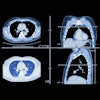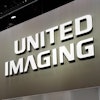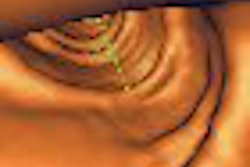CHICAGO - Dual-source CT (DSCT) is the best option for the detection of coronary artery stenosis and the elimination of artifacts created by a patient's heart rate, according to two studies presented on Monday at the 2006 American Heart Association (AHA) meeting.
As a patient's heart beats faster, more artifacts are created in a multislice CT scan. "The technique (using 64-slice CT) is limited by its temporal resolution, which is approximately 160 milliseconds," said Dr. Alexander Leber of the University of Munich in Germany. "This temporal resolution is leading to motion artifacts in heart rates that exceed 65 beats per minute. Therefore, pretreatment of beta-blockers is mandatory and recommended by most groups. On the other hand, this complicates patient management and will lengthen the entire scan procedure."
Strategies to improve temporal resolution, such as multisegment reconstruction, he added, are prone to error and do not provide consistent image quality.
Because of its 90º rotation and use of two x-ray tubes and two detectors, DSCT has a temporal resolution of 83 msec, enabling the technology to obtain more motion-free images of the coronary arteries.
Munich study
The study by Leber and his colleagues in Munich sought to evaluate the diagnostic accuracy and feasibility of DSCT with improved temporal resolution in patients with an intermediate likelihood of coronary artery disease. The research also sought to determine DSCT's accuracy in ruling out stenoses, both per segment and per patient. The evaluation included a separate analysis of patients with high heart rates and those with low heart rates. The researchers reviewed 60 patients who took no medication prior to the scan, had a mean heart rate of 71 bpm, and no known history of coronary artery disease.
The 40 patients in the study were referred for invasive coronary angiography due to atypical chest pain and/or nonconclusive tests for ischemia. A DSCT angiography was performed one day prior to the catheterization procedure using a standardized protocol. The diagnostic accuracy to detect coronary stenosis greater than 50% was compared against quantitative coronary angiography on a segmental basis.
Seventeen patients with heart rates faster than 75 bpm were scanned (Somatom Definition, Siemens Medical Solutions, Erlangen, Germany). Leber reported that in two of the patients significant motion artifacts made assessment impossible. In the remaining 38 patients, 16 coronary stenoses greater than 50% were found at quantitative coronary angiography, and 15 were correctly identified at DSCT angiography, with a sensitivity of 94%.
In 547 of 554 segments, stenoses were correctly eliminated, yielding a specificity of 98%. On a patient basis, DSCT angiography predicted the need for a revascularization procedure in eight of eight patients and correctly excluded significant disease in 26 of 30 patients. In four patients, disease severity was significantly overestimated. Negative and positive predictive values were 100% and 67%, respectively.
The conclusion of the University of Munich study is that DSCT angiography enhances the detection of coronary stenoses with a high degree of diagnostic accuracy, even in patients with high heart rates. Also, in patients with a low prevalence of coronary stenoses (21%), those patients requiring coronary revascularization are detected reliably.
"The remarkable thing about this study is that the positive predictability value remains considerably good with the low prevalence of coronary stenoses," Leber said. Sensitivity, specificity, and positive predictive value "all remained relatively high among patients with high heart rates."
Erasmus analysis
Also on Monday, Dr. Annick Weustink of the Erasmus Medical Center in Rotterdam, Netherlands, presented the findings of a study to prospectively evaluate the diagnostic accuracy of DSCT coronary angiography to detect significant stenosis in patients referred for conventional coronary angiography. The study defined stenosis as greater than 50% lumen diameter reduction.
The researchers examined 30 patients (mean age of 66 years), who experienced atypical chest pain, stable or unstable angina pectoris, and were scheduled for diagnostic conventional coronary angiography. Only patients who were able to perform a 10-second breath-hold were scanned with a DSCT scanner. Patients with contraindications to iodinated contrast material were also excluded, and no beta-blockers were administered prior to the scan.
In the past, studies have demonstrated good results using DSCT in detecting significant coronary stenosis, although, on average, 2.5% of patients could not be evaluated due to coronary motion artifacts.
As for the influence of a patient's heartbeat on diagnostic accuracy, the Erasmus study divided patients into three groups: those averaging fewer than 65 bpm, those at approximately 68 bpm, and those with a mean heart rate of 81 bpm.
The results showed a higher diagnostic accuracy in all segment-based analyses and vessel-based analyses. "It is clear that all coronary arteries were greatly evaluable with CT angiography," Weustink said. In patients with high heart rates, DSCT proved to have a sensitivity of 91%, specificity of 94%, positive predictive value of 68%, and negative predictive value of 93%.
She noted some limitations, particularly with regard to patients with high heart rates. In those cases, the estimated effective CT dose was reduced to 11 mSv, compared with an estimated effective dose of 16 mSv in patients with a low heart rate. Calcium also remains problematic, which was expected, and atrial fibrillation remains a contraindication in CT angiography.
These preliminary results are encouraging, even in patients with fast heart rates and without the use of prescan beta-blockers, Weustink said.
She added that the study did not have enough patients with high heart rates to form a definitive conclusion. "However, in our experience, we do see good image quality in patients with high heart rates, but not in all," Weustink said. "Further investigation has to be done in larger groups of patients with high heart rates to find out the true sensitivity."
By Wayne Forrest
AuntMinnie.com staff writer
November 14, 2006
Related Reading
Dual-source imaging promises better CT scanning, June 15, 2006
Cardiac imaging dazzles, but radiologists can't compete alone, April 10, 2006
Siemens launches new dual-source CT technology, November 17, 2005
Copyright © 2006 AuntMinnie.com




















